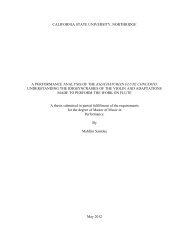Page 1 The California ""- Geographer Annual Publication of the ...
Page 1 The California ""- Geographer Annual Publication of the ...
Page 1 The California ""- Geographer Annual Publication of the ...
You also want an ePaper? Increase the reach of your titles
YUMPU automatically turns print PDFs into web optimized ePapers that Google loves.
Rainfall is slight. In 1938 and again in 1951 <strong>the</strong>re were. two storms<br />
that swept <strong>the</strong> area. From 1961 ,to 1963 <strong>the</strong> total rainfall was scarcely<br />
above two inches, and this small amount fell between January and March.<br />
Fog is not uncommon along <strong>the</strong> entrance channel and near <strong>the</strong> bar<br />
in <strong>the</strong> winter. However, at <strong>the</strong> same time ten miles inland <strong>the</strong> sky is open<br />
and visibility unlimited.<br />
FLORA AND FAUNA<br />
Vegetation <strong>of</strong> <strong>the</strong> dryland fringes <strong>of</strong> <strong>the</strong> lagoon is dominated by salt<br />
bush (S-vraeda californica) and pickleweed (Salicornia virginica). Marsh<br />
grass (Spartina foliosa) is <strong>the</strong> principal species <strong>of</strong> <strong>the</strong> exposed tidal Bats. Eel<br />
grass (Zostera marina) grows at <strong>the</strong> extreme edge <strong>of</strong> <strong>the</strong> tide lines and will be<br />
· found along <strong>the</strong> margins <strong>of</strong> <strong>the</strong> lateral channels down to a depth <strong>of</strong> twenty<br />
feet. Sctlico_rnia blends into heavy stands <strong>of</strong> marsh grass (Bettis) in <strong>the</strong> direction<br />
<strong>of</strong> <strong>the</strong> salt marshes, but toward dry land it phases into Suaeda. Samples<br />
<strong>of</strong> foramenifera taken from <strong>the</strong> beach sands contained abundant concentrations<br />
<strong>of</strong> Elphidium gwnteri and Qwinqueloculina laevigatct. All <strong>of</strong> <strong>the</strong>se<br />
samples contained small amounts <strong>of</strong> Rotorbinella versi, Q. lamarckiana, Q.<br />
limbata, and Q. costata.<br />
<strong>The</strong> most abundant copepod in <strong>the</strong> winter appears to be Acartina<br />
tonsa. Also present with incidental frequency are A. lilljeborgii, Paracalanus,<br />
and Psuedodiaptomus spp. <strong>The</strong> indicator species <strong>of</strong> <strong>the</strong> marshes are<br />
<strong>the</strong> fiddler crab (Uca crenulata) and <strong>the</strong> horn snail (Cerithidae californica).<br />
On <strong>the</strong> Bats one will <strong>of</strong>ten £nd bubble shells (Bulla gouldians), starfish,<br />
and, if one digs, an abundance <strong>of</strong> clams and sweet potatoes (Molpadia<br />
arenisola). Common £shes <strong>of</strong> <strong>the</strong> channels are guitar£sh (Rhinobatos<br />
productus), mullet (Mugil), and species <strong>of</strong> bass (Paralabrax spp). Ducks<br />
and shorebirds, especially whimbrels (Numeniits phaeopus) - and curlews<br />
(N. americanus), are present in <strong>the</strong> winter by <strong>the</strong> tens <strong>of</strong> thousands. Bottlenose<br />
dolphin (Tursiops gilli) and calving gray whales (Eschrichtius gibbosus)<br />
occasionally enter <strong>the</strong> lagoon. .<br />
Among <strong>the</strong> latent resources <strong>of</strong> <strong>the</strong> lagoon complex are those that are<br />
basea on <strong>the</strong> harvest or observation <strong>of</strong> wildlife. One can see multitudes<br />
<strong>of</strong> sea ducks and o<strong>the</strong>r edible waterfowl, since <strong>the</strong>se lagoons lie within<br />
<strong>the</strong> Pacific Byway. Fishing, certainly a likely source <strong>of</strong> recreation, may also<br />
serve as a base for a limited commercial fishery. Green turtles were seen<br />
infrequently. <strong>The</strong>se are used elsewhere on that coast for food, and fishermen<br />
from Isla Cedros enter <strong>the</strong> lagoon to take <strong>the</strong>m for market.<br />
For <strong>the</strong> moment, however, salt processing is <strong>the</strong> sole industry. <strong>The</strong><br />
belt conveyor structure on <strong>the</strong> salt wharf and a gleaming white hill <strong>of</strong><br />
salt nearby dominate <strong>the</strong> Bat landscape from miles around. A stream <strong>of</strong><br />
70-ton tractor-trailer units continually replenishes <strong>the</strong> 45-foot high stockpile.<br />
A two-hundred foot long concrete and sheet piling-faced dock lies<br />
under an adjustable bulk loader, which can be elevated from 30 to 50<br />
feet above <strong>the</strong> wharf.<br />
In 1962, <strong>the</strong> total export was slightly over 2 million tons <strong>of</strong> industrial<br />
grade sodium cloride. During that year 97 vessels Hying <strong>the</strong> Bags -<br />
<strong>of</strong> Japan, Greece, Canada, and <strong>the</strong> United States called and carried awav<br />
33













